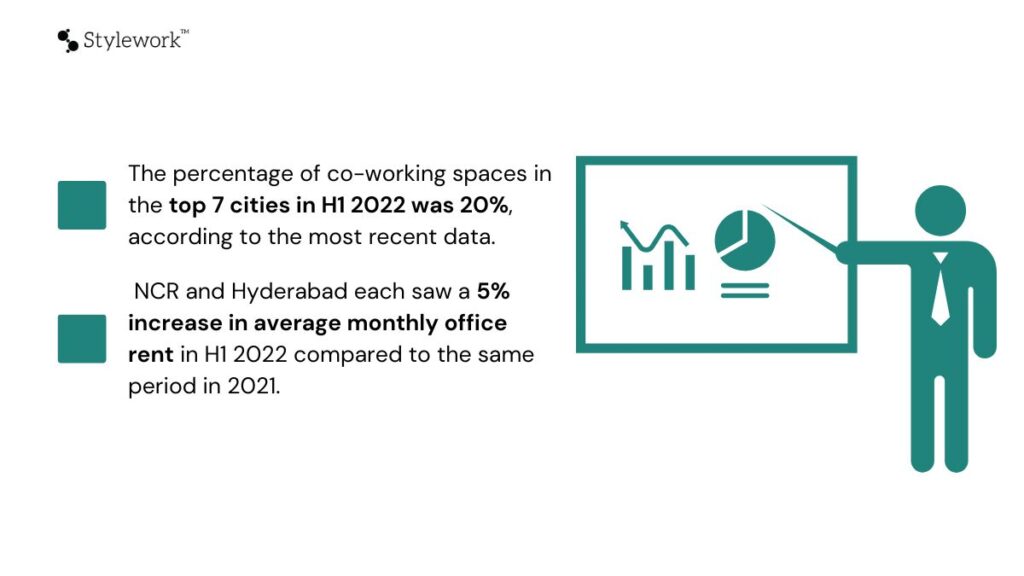Did you know that, after China, India has more than 5000+ flexible coworking spaces, making it the second-largest market for flex coworking spaces in the Asia-Pacific region? Coworking has grown significantly during the last 10 years, which has benefited startups. The flexibility of this type of workplace is one of its main advantages. The concept of coworking makes the networks and contacts formed here quick and easy, which is a significant win for business owners. Therefore, unlike traditional workspaces, coworking spaces offer great networking opportunities, all-inclusive pricing, flexibility, modern amenities, and no administrative hurdles because those tasks are delegated to a third party, especially when you sign up with the tech-enabled flexible space aggregators like Stylework.
Coworking Spaces: The Sought-after Market
- As per industry estimates, the demand for co-working spaces is already 80 to 90% of pre-COVID-19 levels.
- The coworking market size will double over the next 5 years at 15% CAGR as per the CII report.
- The occupancy levels still at best are 35% with larger enterprises still waiting it out.
With large corporations and organizations, including start-ups, now choosing co-working, the percentage of co-working spaces throughout the top 7 cities after COVID-19 scaled up to 20% in H1 2022 as opposed to 6% in the same period of 2021.
Details indicate that Bengaluru, Hyderabad, and Chennai saw net office absorption of approximately 12.2 million square feet, of which coworking players occupied 18% or approximately 2.23 million square feet. While the western markets of Mumbai Metropolitan Region (MMR) and Pune saw net absorption of almost 5.45 million square feet, of which 27% or over 1.5 million square feet were occupied by coworking players. (Data Source: Mint)
Reasons Why Coworking Spaces Are Back in Service
One of the main reasons for the increase in demand is the benefit of flexible office spaces, which allow businesses to plug and play at competitive prices rather than struggle with office layouts and fit-outs. A flexible coworking space enables minimum capital outlay and a ready-to-move-in facility with greater scope for amenities and networking opportunities. The lock-in period for leasing a typical office space is from two to four years. But with leading tech-office space aggregators like Stylework there is no obligation for signing lock-in or lease contracts as such.
Since there is such high demand, co-working spaces are now also operating from numerous large office parks and malls throughout the country. The fact that these areas are not only confined to major employment centers or city centers is a significant element fueling demand. Instead, they are dispersed among various regions, including the suburbs with the residential arena. In many locations, coworking spaces are now also located in hotels and shopping centers. Coworking spaces can be found in a lot of big office parks. This enables businesses to give their workers freedom and maintain a close relationship with them.
Co-Working Spaces – Demand and Supply Dynamics
The Demand Side
Following the epidemic, there has been an increase in the demand for flexible office spaces, with big corporations and businesses, including start-ups, now favoring co-working. The percentage of co-working spaces in the top 7 cities in H1 2022 was 20%, according to the most recent data. Its share was only 6% in H1 2021. In contrast, the IT/ITeS sector’s share—which had been the main driver of office demand in India—declined from 49% to 36%. This decrease is partly attributable to the fact that many IT companies now favor flexible workspaces over traditional office spaces. (Source: CXOtoday.com)

Average monthly office rentals are increasing throughout the major cities, supported by an increase in the demand for office space. For example, NCR and Hyderabad each saw a 5% increase in average monthly office rent in H1 2022 compared to the same period in 2021.
Read More: Why Flexible Workspaces Trending in India
The Supply Side
In H1 2022, the top 7 cities also had a significant increase in the supply of new offices, totaling 31.8 million square feet. With a combined 74% share, Bengaluru, Hyderabad, and Pune were in the lead. Given the high rate of new construction, the average vacancy rate among the top 7 cities increased by 2% to 15.95% in the first quarter of 2022. (Source: CXOtoday.com)
Figures and Forecasts

Here are some numbers and projections to help you gauge the potential scalability of the flex coworking space industry –
- By 2025, analysts project that shared workspace will occupy 30% of all office space.
- India currently has 5000+ spaces, which will increase to 20,000 in 5 years.
- In 2020, coworking space accounted for 3% of all commercial real estate. By 2022, demand for coworking space in some locations had already reached 20%, and in the following three to five years, growth is expected to reach 25%.
- In India, there are 39 million square feet of coworking space, and by 2025, that number is expected to rise to 140 million square feet.
- 63% of spaces are in Tier 1 cities, and 37% are in Tier II, III, and IV cities. According to predictions, there will be a 50:50 ratio in the next three to four years.
- Growth of the coworking industry within commercial real estate in 5-7 years is expected to grow to 18-26 pc.
We intend to expand our operations further to tier 2 and tier 3 cities and 3600+ spaces spread across 160+ cities in India by the end of next year in order to meet the market’s demands and not only secure establishments in prominent or downtown areas but also in the remotest places or areas with less connectivity, and in non-metro cities as well to create a chain of decentralized workspace ecosystem.

